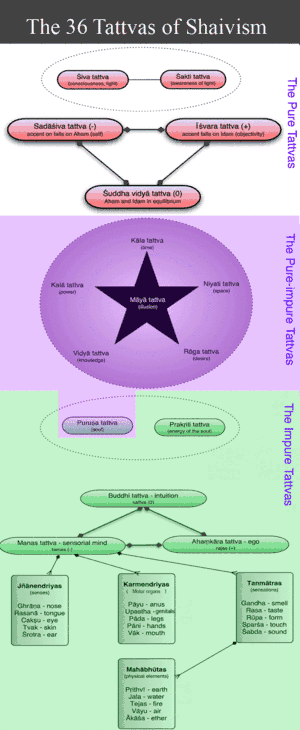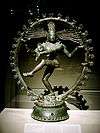Tattva (Shaivism)
| Part of a series on |
| Shaivism |
|---|
 |
|
Scriptures and texts |
|
Schools
Saiddhantika Non - Saiddhantika
|
|
Others
|
|
|
The tattvas are the cascades, essences, elements or principles of reality.[1][2] Tattvas are the basic concepts to understand the nature of absolute, the souls and the universe in Shaivite and Samkhya philosophies. Shaivaite philosophies count them as thirty six while Samkhya philospophy defines them as twenty five.[3]
Tattvas are used to explain the creation and the existence of the Universe. They are usually divided into three groups: Shudda, (pure) tattvas; Shuddhashuddha (pure-impure) tattvas; and Ashuddha (impure) tattvas. The pure tattvas describe internal aspects of the Absolute while the pure - impure tattvas describe the soul and its limitations. The impure tattvas include the universe and living beings that assist the existence of soul.[4]
Introduction
According to Shaivite philosophies, Parashiva or Parameshwara is the ultimate Reality or Parabrahman, "the one form where everything emerges. [5] The nondualistic monism school of Shaivism, Kashmir Shaivism, describes the tattvas as Paramshiva manifests himself by a process of descent from Paramashiva to jiva, through the 36 tattvas.[web 1] Spanda, The vibrant creative energy of Parashiva known as Spanda, moves him to manifest himself these 36 tattvas as a leela or divine play.[6]
Another important sect of Shaivism, Shaiva Siddhanta, a monism cum dualistic school describes the tattvas in a different perspective. Passive parameshwara is activated itself by Suddha Maya or divine grace (Shakti) of him. Like that, the universe, (Prakriti), is activated by ashudda Maya (physical body and all aspects of universe), another aspect of divine grace - Mahamaya. The interaction of Pure Maya and Impure Maya is the Pure - impure Maya where the souls (Pashus) attain knowledge which leads to the existence of whole universe.[2]

Mahamaya or divine grace of Lord, divides itself into three aspects - Suddhamaya, Suddha asuddha maya and Asuddha maya and causes five, seven, twenty four tattvas respectively.[7] Five pure tattvas are known as Saiva tattvas while seven pure - impure tattvas are known as Vidya tattvas. Twenty four impure tattvas are known as Atma tattvas. Samkhya philosophy considers there exist only 25 tattvas - twenty four atma tattvas along with atman or soul.[8]
Five pure tattvas

Suddha tattvas, also known as Saiva tattvas are functioning in the absolute level which leads to the Panchakritya (Five acts) - Creation-Maintenance-Destruction-Concealment-Grace of almighty.[9] Suddha tattvas are called pure because they are directly created by Shiva himself.[web 1]
Siva
Also known as Sakala tattva. One of the two aspects of omniscience, omnipresent conscious absolute. In this essence, god doesn't consists of any desire (Ichcha), action (Kriya) or Knowledge (Jnana) related properties. It is in its pure conscious state.
Sakti
Another aspect of absolute. Pairing of Siva-sakti causes the creation of all following tattvas. The paired Sivasakti is omniscience and consistently active. These two properties of Sivasakti are known jnana and kriya respectively in philosophical terms.
Sadakya
Sadasiva tattva or Nāda tattva. This tattva is responsible for the appearance of aham or self. This results in Ishvara tattva. In this level, kriyashakti and jnana sakti of almighty is equal to each other.
Ishvara
Aso known as Bindu tattva. The tattva where the fourth act of Panchakritya - delusion or concealment happens. Ishvara tattva activates the souls which are concealed by Pasams . Idam, the objectivation of self-awareness or "this is myself" is caused by Ishvara tattva.[web 1]
Suddha Vidya
Also known as Sadvidya tattva or kriya tattva. Jnanashakti is more initiative than kriyasakti in Suddhavidya tattva. Here, "self - ness" and "this-ness" become balanced. [web 1] other three acts of Panchakritya - creation, maintenance and destruction are done below suddhavidya.
These five tattvas are almighty himself which leads to the moksha of souls. Or this five tattvas can be seen as retrogradation of souls from lower state to its higher steps towards liberation. Souls are in their re-incarnation cycles in suddha vidya tattva. Matured souls leave the re-incarnation cycle and enters sadakya tattva where they become free from "Pasam" - the bondages of Anava, Karma and Maya. Sakti drenches the souls in its divine grace at Bindu tattva and let it towards Nada tattva where it attains moksha at Siva tattva.[7]
Seven pure-impure tattvas

Pure-impure tattvas or Vidya tattvas are described as the "instruments" that assist the souls for their liberation. Soul or Atman is considered as "Purusha tattva" here, while the final manifestation of almighty is known as "Maya tattva". Maya manifests into five more tattvas known as "kanchukas"[10] and these six tattvas adjoins the pusursha tattva and thus, produce seven vidya tattvas.
Maya
Maya hides the Divine nature of created beings, and it creates the sense of separateness and further evolved into five kunchukas.
Kanchukas
Can be fairly translated as cloaks. Kancukas cover the Divine nature of sentient beings.
- Kāla - the time
- Vidya - causes misperception, limited knowledge
- Rāga Tattva - responsible for desire
- Niyati tattva - limitations of causality
- Kalā or 'Akāla - limited power.[web 1]
Purusha
Purusha is the soul. It pairs with maya, the final manifestation of god along with five kancukas. These five vidya tattvas are idle in nature. So, Siva joins with maya and Sakti joins with three kancukas - Kāla, Niyati,Kalā. Sadasiva joins with purusha and Suddhavidya operates vidya tattva. Raga is operated by Ishvara.[7] The activated purusha with other vidya tattvas cannot exist in universe solely. There comes the assistance of upcoming 24 asuddha tattvas.
Twenty four impure tattvas
Impure tattvas or Atma tattvas are aspects of universe and physical body.
Four Antakaranas
Impure Maya operates atma tattvas with four manifestations known as "Antakaranas".
- Manas or mind
- Buddhi or intuition
- Ahamkaram or ego
- Siddha or Prakriti (energy of the soul)
Buddhi is the irst tattva developed in impure tattva. It is modified into Manas and Ahamkaram. Ten indriyas (five sense organs and 5 motor organs) are modification of Ahamkara tattva while five tanmatras (sensations), which evolves into five mahābhūtas (physical elements). These whole ultimate limit of entire manifestation results in Prakriti tattva = totally 24 tattvas.[11]
Five sense organs
Known as jñānendriyas. They represent the lunar, passive function of manas. The five jñānendriyas (sense organs).
- ghrana (nose)
- rasana (tongue)
- caksu (eye),
- tvak (skin), and
- srotra (ear).
Five motor organs
The Karmendriyas. Karmendriyas represent both the physical organs and the corresponding subtle (astral) organs of action, specific to activity in the astral plane. Karmendriyas are karma indriyas (the combination of final 'a' and first 'i' become an 'e'), that is internal organs that create action (karma). They are connected directly to the manas tattva, and represent its solar, active function.
- payu (anus) - harmonious activation of pāyu is essential for obtaining control of such an energy. This is why many techniques involving pāyu tattva are methods of awakening of kundalini energy
- upashta (sexual organs) - means the power of procreation and sexual enjoyment, or the generative organ.[12]
- pada (legs) &
- pani (hands) - represents both the physical organ of locomotion and the subtle energetic structures associated with it. Between the seven force centers it is associated with Manipura Chakra[13] and in the hierarchy of 36 tattvas it is a superior octave of tejas tattva.
- vak (mouth) - speech acts as a mirror of the exterior reality, duplicating everything that exists outside into the mind. Vak tattva plays a major creative role in the human being as the instrument of speech and as such, the origin of the interior world of thought.[14]
Five sensations
The five tanmatras.
- gandha (smell)
- rasa (taste)
- rupa (form)
- sparsa (touch) and
- sabda (sound).
Five Mahabhutas
The five elements that produce the nature of universe. They represent the final point of manifestation, where light (Prakāśa) is condensed into matter, yet the mahābhūtas remain identical with Shiva.[15]
- prithvi (earth),
- jala (water),
- tejas (fire),
- vayu (air), and
- akasa (ether).
While mahābhūtas are the basis for the material world, tanmātras are but limited aspects and views of it, in no way able to fully describe it. We cannot actually perceive the reality, all we can access are limited "bands" of information that form a description of reality. These bands of information are the five tanmātras.
This restriction however applies only to the limited beings (jiva, or aṇu). For one who has gone beyond māyā, in the realm of the pure tattvas, there can be direct perception of reality, because as one's self is Ātman, so are the external objects. In such a state an enlightened being can perceive the world beyond the five senses (direct perception), in a state of diversity in unity and unity in diversity.[16]
See also
- Aṇḍa, the four spheres of reality
- Tattva (Samkhya)
- Shaiva Siddhanta
- Trika
- Three Bodies Doctrine (Vedanta)
References
- ↑ Jagadish Chandra Chatterji (1914). Kashmir Shaivism. SUNY Press. ISBN 9780887061790.
- 1 2 "Tattvas = 36". Veeraswamy Krishnaraj. Retrieved 5 March 2017.
- ↑ Philosophy East & West. University Press of Hawaii,. 1983. p. 223.
- ↑ Mathew Chandrankunnel (2008). Philosophy of Quantum Mechanics. Global Vision Publishing House,. ISBN 9788182202580.
- ↑ T. V. Mahalingam (1990). South Indian studies. Geetha Book House.
- ↑ Acharya Kedar (2003). The Sutras on the 5-Fold Act of Divine Consciousness. ISBN 0595293891.
- 1 2 3 Jayandra Soni (1989). Philosophical Anthropology in Śaiva Siddhānta: With Special Reference to Śivāgrayogin. ISBN 8120806328.
- ↑ Philosophical Series, Issue 7. University of Madras. 1960.
- ↑ Kapila Vatsyayan (1996). Concepts of Time, Ancient and Modern. Indira Gandhi National Centre for the Arts.
- ↑ Chandradhar Sharma (2000). A Critical Survey of Indian Philosophy. Motilal Banarsidass Publications. p. 389. ISBN 9788120803657.
- ↑ Abhinavagupta, Jaideva Singh. A Trident of Wisdom: Translation of Paratrisika-vivarana. SUNY Press. ISBN 9780791494127.
- ↑ Introduction to Kashmir Shaivism, Gurudev Siddha Peeth, Ganeshpuri, 1975, pag. 33
- ↑ Panels of the VIIth World Sanskrit Conference: Kern Institute, Leiden, August 23–29, 1987, Johannes Bronkhorst, pag. 58
- ↑ "Jnānam bandhaḥ", The Shiva-Sutra Vimarsini of Ksemaraja, P.T. Shrinivas Iyengar, page 5
- ↑ The Pratyabhijñā Philosophy, G.V.Tagare, 2002, pag. 25
- ↑ Institute for Encyclopedia of Human Ideas on Ultimate Reality and Meaning (2001). Ultimate Reality and Meaning, Volume 24. Van Gorcum. p. 9.
Sources
- Lakshman Joo, Swami (1988). Kaśmir Śaivism. pag. 1
- Eliade, Mircea. Theory and History of Religion. cap. 6 and 7
- Singh, Jaideva (1979). Siva Sutras: The Yoga of Supreme Identity. Delhi: Motilal Banarsidas.
Web-sources
External links
- 36 tattvas - an easy explanation
- Piyaray L. Raina, Kashmir Shaivism versus Vedanta – A Synopsis (includes an overview of the tattvas)
- Daniel Odier, SHIVA AND HIS UNIVERSAL MANIFESTATION
